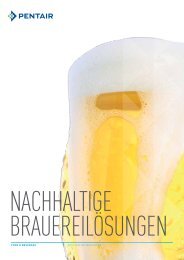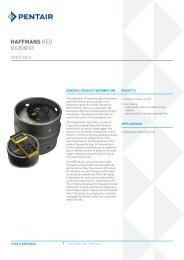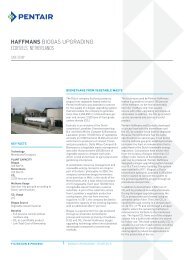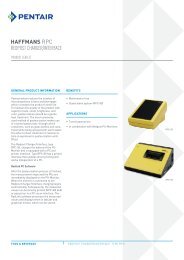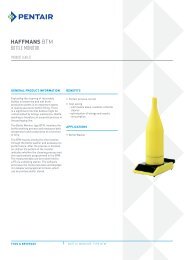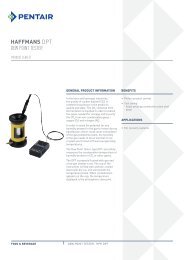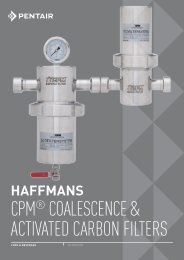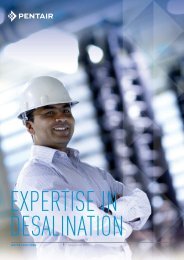Download case study - Haffmans
Download case study - Haffmans
Download case study - Haffmans
- No tags were found...
Create successful ePaper yourself
Turn your PDF publications into a flip-book with our unique Google optimized e-Paper software.
HAFFMANS CO 2RECOVERY SYSTEMMOLSON COORSCASE STUDYA DURABLE SUSTAINABLE SOLUTIONKEY FACTSLocationBurton on TrentApplicationBreweryCapacity2,000 kg/h CO 2Start-Up2010One of the United Kingdom’s largest andmost modern carbon dioxide (CO 2) recoveryplants at a brewery is in operation atMolson Coors with a 24/7 capacity of 2,000kg/h CO 2.Molson Coors Brewing Company brews,markets and sells a portfolio of leadingbrands across North America, Europeand Asia. It operates in Canada throughMolson Coors Canada; in the U.S. throughMillerCoors. In the UK, Molson Coors (UK& Ireland) has over 2,000 employees andbreweries in Burton on Trent, Alton andTadcaster. Its portfolio includes Carling, theUK’s best selling lager for three decades,Coors Light, Grolsch, Worthington’s,Caffrey’s, Corona, Cobra and a range ofspeciality beers.The Burton Brewery, a fusion of twoneighboring breweries, has a capacity offive million UK barrels per year. Even today,the tradition of two breweries in the sametown on the same site remains. MolsonCoors (UK & Ireland) continues to brewbeer in separate production sites, nowcalled North and South.CO 2 – an essential brewing elementAfter entering the UK brewing marketin 2002 Molson Coors continued topurchase CO 2, which at the time wasmainly derived from non-natural and oldchemical production processes. Againstthis backdrop, Molson Coors looked into aCO 2 recovery system in 2005. But becauseCO 2 price, quality and availability wereacceptable in the UK at that time, theinvestment was postponed.In 2008, several major CO 2 productionfacilities closed and, as a result, manybeverage producers faced bottlenecks.Due to the shortage, CO 2 became veryexpensive. In 2009, Molson Coors restartedthe CO 2 recovery system project with cleargoals. First, the brewer wanted to be CO 2self-sufficient. Carbon dioxide is essentialfor beer production. Molson Coors did notwant to risk running out of CO 2, a lessonthey learned during the UK’s CO 2 shortage.Secondly, they wanted a solution that wasenergy efficient. Moreover, the systemhad to be durable as this was a long-terminvestment.Molson Coors needed a single solutionto meet the CO 2 needs for both the Northand the South breweries. This posed aspecial challenge for the CO 2 collection anddistribution system. The CO 2 is collectedin only one of the two breweries and thendelivered to all operating sites. At the Southsite, for example, can filling is located,while the bottle and keg filling is at theNorth site. That means long distances forthe CO 2 to travel.The solution was to source the green shortcycleCO 2 generated during fermentation.Pentair <strong>Haffmans</strong> had the responsibility forprocessing, storage and evaporation of theCO 2. Moreover, the company’s expertise wasessential for the entire process chain, fromthe collection at the fermenters throughtransporting the CO 2 to where it is used.The road to “Green CO 2 “During beer fermentation, nearly equalamounts of alcohol and CO 2 are generated.Roughly, 2.5 kg CO 2 per hectoliter of beercan be recovered from an original wort of12 degrees Plato. Considering a beer of 13degrees Plato this would amount to roughly2.9 to 3 kg of CO 2.FOOD & BEVERAGECO 2 RECOVERY
HAFFMANS CO 2RECOVERY SYSTEMMOLSON COORSCASE STUDYGREEN CO 2Before the green CO 2 is used, it mustbe purified. The CO 2 generated duringfermentation contains several impuritiesincluding dimethyl sulfide (DMS), hydrogensulfide (H 2S), and oxygen (O 2) that must beremoved as they have a negative effect ontaste, odor and shelf life on the finishedproduct. A state-of-the-art CO 2 recoverysystem is a cost-effective, sustainable wayto purify the CO 2 to food-grade quality. Sucha system includes the following steps:• Foam separator• Gas balloon• Gas washer• CO 2 compressor• Activated carbon filter• Dryer• CO 2 condenser• Storage tankCollection of the CO 2 is mainly from thetop of the fermenters. Other sources arethe maturation vessels and the brightbeer tanks. The necessary inlet purity forthe treatment of the CO 2 depends on theinstalled technology and ranges from 95 to99.7 percent.Up to 60 percent energy recoveryMost of the energy consumed during theCO 2 recovery process is used during gascompression, removal of off-flavors, to drythe gas, and during CO 2 liquefaction andvaporization. However, there are a numberof reverse processes in the recoverysystem. Carbon dioxide, for example, is firstliquefied and in the next step vaporized.This means that a great amount of energymust be extracted, while later almost thesame amount of energy is added again.Another example is the compression of thegas. Before the gas is sent to the brewery,the pressure must be slightly reduced. Bylinking such processes together, both insideand outside of the recovery process, costscan be considerably reduced and the netenergy use for CO 2 recovery can be reducedby up to 60 percent.The heat recovery system, type LiquiVapmakes it possible to liquefy the CO 2 whileusing very little energy for cooling. If CO 2production and consumption take placesimultaneously, there is an immediateenergy saving because the extractedCO 2 can be used to liquefy the CO 2. Attimes when there is no CO 2 productionor consumption, it is possible to liquefyor vaporize CO 2 in the traditional way, forexample, at the start of the week when thefermentation has not yet started, but thebeer is already being bottled, canned or putin kegs.By using the LiquiVap system wheneverpossible, Molson Coors saves energy ina number of processes, including CO 2condensation energy with the release ofheat to the centralized brewery coolingsystem linked to it, when pre-cooling thecooling water, and as the energy necessaryto vaporize CO 2. However, the heat recoverysystem cannot cool more than is actuallyevaporated. For example, the capacity ofa plant like the system installed at MolsonCoors is 2,000 kg/h.During production, only 1,000 kg/h CO 2 isneeded and therefore only 1,000 kg/h canbe cooled down by the LiquiVap system. Forthe remaining 1,000 kg/h a separate coolingmethod is necessary. The control systemaccurately regulates the plant so it usesonly the energy for the 1,000 kg/h. Optimumenergy efficiency is always reached – andLiquiVap CO2 condenserGas washer column and CO2 collection balloonup to 60 percent of the energy consumptioncan be saved. Water consumption is alsosignificantly reduced.In operation since mid 2010, Pentair<strong>Haffmans</strong>’ CO 2 recovery systemencompasses production, processing,storage and distribution at Molson Coors’Burton-on-Trent brewery and runs 24/7. Afive-year Service Level Agreement betweenMolson Coors and Pentair <strong>Haffmans</strong> wasput into place in 2011 to maintain the highperformance level.HAFFMANS BVP.O. BOX 3150, 5902 RD VENLO, NETHERLANDS WWW.HAFFMANS.NLAll Pentair trademarks and logos are owned by Pentair, Inc. All other brand or product names are trademarks or registered marks of their respective owners.Because we are continuously improving our products and services, Pentair reserves the right to change specifications without prior notice.Pentair is an equal opportunity employer.Molson Coors E-5/12 © 2012 Pentair, Inc. All Rights Reserved.



